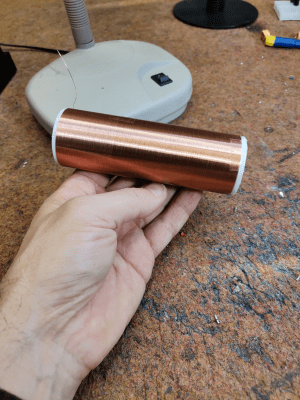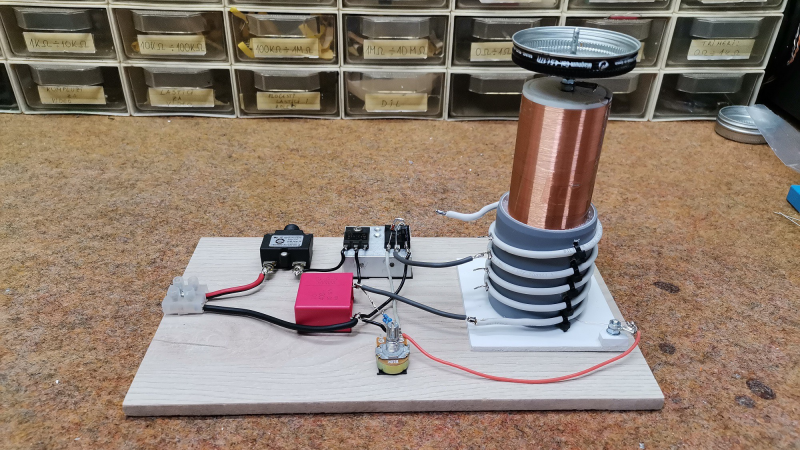Tesla coils are one of those builds that capture the interest of almost anybody passing by. For the naïve constructor, they look simple enough, but they can be finicky beasts—beasts that can bite if not treated with respect. [Mirko Pavleski] has some experience with them and shares it with us over on Hackaday.io. One of the first big improvements of this build style is the shift from the originally used spark gap commutator to that of a direct AC drive via a MOSFET oscillator. This improves the primary drive power for its size and eliminates that noisy spark gap. That’s one less source of broadband RF noise and the audible racket these produce.

The primary side of a Tesla coil is usually a handful of turns of thick wire to handle the current without melting. This build runs at two or three amps, giving a primary power of around 150 Watts. However, this is quite a small unit; with larger ones, the power is much higher, and the resulting discharge sparks much longer. On the secondary side, the air-coupled coil is formed from 520 turns of much thinner wire since it doesn’t need to convey so much current. That’s the thing with transformers with large turns ratios — the secondary voltage will be much higher, and the current will be correspondingly much lower. The idea with Tesla coils is that the secondary circuit forms a resonant circuit with the ‘top load’, usually some hollow metal can. This forms an LC circuit with a corresponding resonant frequency dependent on the secondary inductance values, the object’s capacitance and anything else connected. The primary circuit is designed to resonate at this same frequency to give maximum power coupling across the air gap. Changing either circuit can spoil this balance unless there is a feedback circuit to keep it in check. This could be with a sense coil, a local antenna or something more direct, like in this case.
To ensure the primary circuit doesn’t melt, it needs to be able to drive a reasonable current at this frequency, often in the low MHz range. This leads to a common difficulty: ensuring the switching transistor and rectifying diode are fast enough at the required current level with enough margin. [Mirko] points out several components that can achieve the operating frequency of around 1.7 MHz, which his top load configuration indicates.
For a bit more info on building these fascinating devices, you could check out our earlier coverage, like this useful guide. Of course, simple can be best. How about a design with just three components?

















Is 1.7 MHz an ISM frequency? I don’t think so.
Try for one of the many ISM frequencies to make this legit.
That’s not what makes it legit.
What makes it legit is the Q-factor of the secondary. I just typed the specs into a calculator and the Q came out as 485, which is very very good for a coil.
At resonance the Q-factor multiplies the voltage of the secondary, so he’s getting a factor of 100 (about) for the transformer and another factor of 485 for the resonance for a total voltage multiplication of about 50000.
Given that 485 is leaning into the “technically possible but physically not feasible” range, it’s probably more like 200, the capacitor is not super good so might be lower Q than optimal, and there’s probably other issues we can’t see that bring the Q-factor down.
It looks like he’s getting 8″ or 10″ of spark from the needle, which is about 50 kV, which is very good for a small tesla coil. I’ve seen coils that only get an inch or two of spark from much larger builds because the builder doesn’t understand Q-factor multiplication.
Tesla coils aren’t just transformers, you need to take resonance into account as well.
Also, it’s well laid out and well documented. It’s also galvanically isolated, so it’s pretty safe.
This is a very good build.
I think you missed the OP-s point. He’s not talking about technical side, he is talking about legal use of the frequency. Tesla coil is very strong radio transmitter, and 1.7MHz is not free to use. It is above MW broadcast band and bellow amateur 160m band, in the area used by various coast guards which won’t be happy. From the Wikipedia: “There are a number of coast guard and other ship-to-shore frequencies in use between 1600 and 2850 kHz. These include, as examples, the French MRCC on 1696 kHz and 2677 kHz, Stornoway Coastguard on 1743 kHz, …”
Sometimes someone will say something and everything finally clicks into place. I’ve seen articles on Tesla coils for years but didn’t ‘get’ them until I saw your mention of circuit ‘Q’. I was familiar with Q but didn’t understand its importance in this application until just now. TNX.
Available for use:
https://github.com/ToolChainGang/Inductance
I’d like to hear more about the legality or illegality of this great coil I terms of RF
I did this years ago
And even managed to audio modulate a single transistor coil
Replace the bjt style transistor with a MOSFET or igbt and a driver chip
Use a pulse interrupt style or a 555 timer to run a hi quality cw audio
https://youtu.be/XQ-fNfEwp7w?si=wizltd5C4ZfQIuz-
Single transistor
Some cheating to modulate am signal injected directly into voltage rail
Better using a toroidal transformers but downside is that these frequency it can get noisy…
Take a speaker coil and there you go, primary drive coil, and hook secondary series inline with + either 1:1 or like 1:2 ratio and hooks to any old stereo amp with better isolation
Hmmmm.
My friendly Chinese shop sells a “Bd243 mini tesla kit” for 5 €. Has one BD243. Works fine on my desk.
Ok, it is not of that impressive size.
1.7 MHz, definitely not ISM. Not a good choice if you ask the current licensed users. Check Wikipedia for an ISM frequency list, many of which are harmonically related to curb interference.
You might do well with the one around 6.8 MHz, just be sure your fundamental stays in that band.